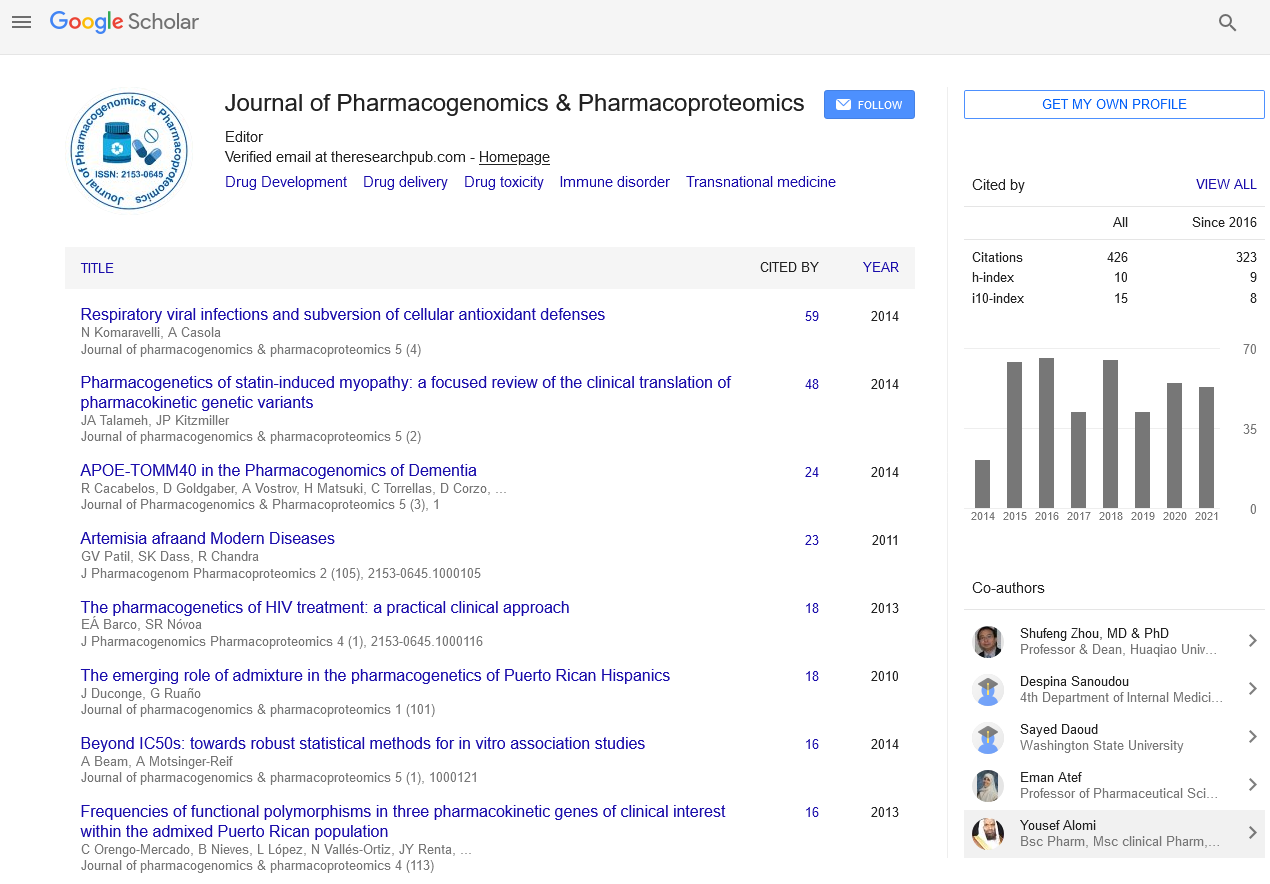Indexed In
- Open J Gate
- Genamics JournalSeek
- Academic Keys
- JournalTOCs
- ResearchBible
- Electronic Journals Library
- RefSeek
- Hamdard University
- EBSCO A-Z
- OCLC- WorldCat
- Proquest Summons
- SWB online catalog
- Virtual Library of Biology (vifabio)
- Publons
- MIAR
- Euro Pub
- Google Scholar
Useful Links
Share This Page
Journal Flyer

Open Access Journals
- Agri and Aquaculture
- Biochemistry
- Bioinformatics & Systems Biology
- Business & Management
- Chemistry
- Clinical Sciences
- Engineering
- Food & Nutrition
- General Science
- Genetics & Molecular Biology
- Immunology & Microbiology
- Medical Sciences
- Neuroscience & Psychology
- Nursing & Health Care
- Pharmaceutical Sciences
Gut-brain signals following stress: Updates from integration by Shugan
JOINT EVENT ON 6th European Conference on Predictive, Preventive and Personalized Medicine & Molecular Diagnostics & 2nd World Congress on Human Genetics
September 14-15, 2017 | Edinburgh, Scotland
Xi Huang, Ping Ren, Yin-Jing Zhang, Ying Xie, Min Luo, Jin Liu, Muhai Lin, Yun Wang, Zhe Xiao, Dao-Zhou Mu, Yi Chen, Hongbin Yan and Wan Zheng
Nanjing University of Chinese Medicine, China
Second Xiangya Hospital of Central South University, China
Xiamen University Medical School, China
Scientific Tracks Abstracts: J Pharmacogenomics Pharmacoproteomics
Abstract:
Considerably clinical and experimental evidences accumulated show bidirectionally interactions between FGIDs (functional gastrointestinal disorders) and depression following stress via gut-brain signals including α2-AR, ghrelin(Ghr), IL-1, NO and kynurenine (AGINK). All AGINK signals have not been pharmacodynamically integrated by simultaneous antidepressants and mediating gut motor (A&M) because there are no A&M agents. In fact, such A&M effects by Shugan of TCM formulae often occur separately in different publications. We aim to elucidate and integrate gut-brain signals following stress via evidences from literature and simultaneous A&M compounds from Shugan�??s herbs in our previous and recent studies. Available conclusions include: 1) AGINK are better gut-brain signals than other molecules, supported by more evidences separately involved in depression and FGIDs. Of these, no one had been integrated by simultaneous A&M pharmacology before 2013; 2) Such action has been theoretically described for thousands of years and separately occurred for hundreds of years among several decades of TCM formulae and their compounds. However, no one had tested its synchronous A&M efficacy before; 3) For the first time: via mediating HPA axis hormones, 5-HT/NA/ DA (involved in antidepressants) and Ghr (involved in prokinetic) concentration, concurrent A&M (the latter action is prokinetic) efficacy induced by Chaihu-Shugan-San (CSS) formula and its absorbed compound ferulic acid happened when compared by us in 2011. Such antidepressant and prokinetic (A&P) action also occur after oral meranzin hydrate (MH), hesperidin, peoniflorin and Senkyunolide to rat swept forcedly in our recent works, mediating by IL-1, 10β, oxidation stress, kynurenine and BDNF/p-mTOR, specially AMPA-ERK1/2BDNF pathway for fast antidepressant without side effect similar to Ketamine. 4) α2-AR of disorder in gut-brain axis following FST to rat was integrated by MH-produced simultaneous A&P pharmacology, suggesting first shared molecular of A&P. Second shared molecular is Ghr. Shugan- and A&P-integrated shared molecules highlight personalized overlap of depression and FGIDs, suggesting potentially clinical biomarker in future.
Biography :
Xi Huang has completed his PhD from Fouth Military Medical University (FMMU) in 1995 and Post-Doctoral studies from Xiyuan Hospital, China Academy of Chinese Medicine Science in 1998 respectively. He is the Director and Professor of institute of TCM-related depressive comorbidity, Nanjing University of Chinese Medicine (NUCM). He is respectively Lead Clinician in Xijing Hospital of FMMU, West China Hospital of Sichuan University and Xiangya Hospital of Central South University of China. He has got 9 funds of National Natural Science Foundations of China. He is Corresponding Author of more than 200 papers out of which 41 are involved in TCM in SCI journals. He is Editorial Board Member or Correspondent Reviewer of more than 10 reputed journals. He is Chairman of Basic Theory Committee of China Association of Integrated Medicine.


